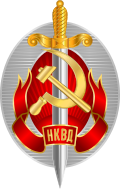
Back المفوضية الشعبية للشؤون الداخلية Arabic NKVD AST SSRİ Xalq Daxili İşlər Komissarlığı Azerbaijani СССР Эске эштәр халыҡ комиссариаты Bashkir NKVD BAT-SMG Народны камісарыят унутраных спраў СССР Byelorussian Народны камісарыят унутраных справаў BE-X-OLD Народен комисариат на вътрешните работи Bulgarian নারোদনি কমিসারিয়াত ভ্নুতরেন্নিখ দিয়াল (এন.কে.ভি.ডি) Bengali/Bangla NKVD Breton
| Народный комиссариат внутренних дел Narodnyi komissariat vnutrennikh del (NKVD) | |
 NKVD emblem | |
| Agency overview | |
|---|---|
| Formed | 10 July 1934 |
| Preceding agencies |
|
| Dissolved | 15 March 1946 |
| Superseding agencies | |
| Type | • Law enforcement • Gendarmerie • Border guard • Prison authority |
| Jurisdiction | Soviet Union |
| Headquarters | 11-13 ulitsa Bol. Lubyanka, Moscow, RSFSR, Soviet Union |
| Agency executives |
|
| Parent agency | Council of the People's Commissars |
| Child agencies |
|
The People's Commissariat for Internal Affairs (Russian: Наро́дный комиссариа́т вну́тренних дел, romanized: Naródny komissariát vnútrennih del (NKVD), pronounced [nɐˈrodnɨj kəmʲɪsərʲɪˈat ˈvnutrʲɪnʲɪɣ dʲel]), abbreviated NKVD (НКВД ⓘ), was the interior ministry of the Soviet Union.
Established in 1917 as NKVD of the Russian Soviet Federative Socialist Republic,[1] the agency was originally tasked with conducting regular police work and overseeing the country's prisons and labor camps.[2] It was disbanded in 1930, and its functions were dispersed among other agencies. Then it was reinstated as an all-union commissariat in 1934.[3]
The functions of the OGPU (the secret police organization) were transferred to the NKVD around the year 1930, giving it a monopoly over law enforcement that lasted until the end of World War II.[2] During this period, the NKVD included both ordinary public order activities, and secret police activities.[4] The NKVD is known for political repression and for carrying out the Great Purge under Joseph Stalin. It was led by Genrikh Yagoda, Nikolai Yezhov, and Lavrentiy Beria.[5][6][7]
The NKVD undertook mass extrajudicial executions of citizens, and conceived, populated and administered the Gulag system of forced labor camps. Their agents were responsible for the repression of the wealthier peasantry.[8] They oversaw the protection of Soviet borders and espionage (which included carrying out political assassinations).
In March 1946 all People's Commissariats were renamed to Ministries. The NKVD became the Ministry of Internal Affairs (MVD).[9]
- ^ Semukhina, Olga B.; Reynolds, Kenneth Michael (2013). Understanding the Modern Russian Police. CRC Press. p. 74. ISBN 978-1-4822-1887-9.
- ^ a b Huskey, Eugene (2014). Russian Lawyers and the Soviet State: The Origins and Development of the Soviet Bar, 1917–1939. Princeton University Press. p. 230. ISBN 978-1-4008-5451-6.
- ^ Semukhina, Olga B.; Reynolds, Kenneth Michael (2013). Understanding the Modern Russian Police. CRC Press. p. 58. ISBN 978-1-4398-0349-3.
- ^ Khlevniuk, Oleg V. (2015). Stalin: New Biography of a Dictator. Yale University Press. p. 125. ISBN 978-0-300-16694-1.
- ^ Yevgenia Albats, KGB: The State Within a State. 1995, page 101
- ^ Robert Gellately. Lenin, Stalin, and Hitler: The Age of Social Catastrophe. Knopf, 2007 ISBN 978-1-4000-4005-6 p. 460
- ^ Catherine Merridale. Night of Stone: Death and Memory in Twentieth-Century Russia. Penguin Books, 2002 ISBN 978-0-14-200063-2 p. 200
- ^ Viola, Lynne (207). The Unknown Gulag: The Lost World of Stalin's Special Settlements. New York: Oxford University Press.
- Applebaum, Anne (2003). Gulag: A History. New York: Doubleday.
- ^ Statiev, Alexander (2010). The Soviet Counterinsurgency in the Western Borderlands. Cambridge University Press. ISBN 978-0-521-76833-7.
© MMXXIII Rich X Search. We shall prevail. All rights reserved. Rich X Search